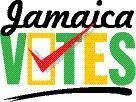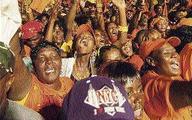Hartley Neita, Gleaner Writer



Left: Jamaica Labour Party supporters at a rally in Mandeville, Manchester, on Sunday, July 1. - Ian Allen/Staff Photographer Right:People's National Party supporters at their mass rally in Half-Way Tree on Sunday night. - Ricardo Makyn/Staff Photographer
An interesting fact in our political history is that it was the People's National Party (PNP) which first commissioned the design for a flag to identify it as an organisation. And it was Sydney Veitch who asked Edna Manley to design the flag.
It was also the PNP which first adopted a party anthem, Jamaica Arise. The words for that anthem were written by William Seivright and the music composed by one of Jamaica's great tenors, Granville Campbell. The PNP was also the first party to adopt a colour, orange, as its party colour. Actually, it was the public relations firm PRO Communications, headed by Ralston Smith, Desmond Henry and Ken Jones, which introduced the colour orange as the theme for P.J. Patterson's first political campaign in South East Westmoreland. It became the PNP's colour in the 1972 general elections campaign.
It was not until Edward Seaga became leader of the Jamaica Labour Party (JLP) in the mid-1970s that a serious look was taken at its image. The party had just been beaten by the PNP in 1972 in a campaign which was probably the best co-ordinated public relations programme by any of the parties up to then. It was a campaign which used a symbol, the rod of correction, music, Rastafarian and African themes such as 'I 'n' I' and 'Hail the Man', and fly whisks, shirts and robes, a slogan 'Time For a Change' which had relevance to the time, and a dramatic advertising campaign.
In 1972, the JLP's slogan was a wordy, 'The JLP Has Done More for You since Nineteen Hundred and Sixty Two'. It was supposed to be poetic but it was too long, not as snappy and easily remembered as the PNP's 'Sweep Them Out' in 1955, and 'Time For A Change' in 1972.
Stand up Jamaica
The JLP's 1980 campaign was, however, as dramatic. Its slogan, 'Deliverance Is Near' captured the mood of much of the society, and its 'Change without Chaos' manifesto was a vision of hope. A party anthem was also commissioned and according to 'Babsie' Grange, the outcome, Stand up Jamaica, was a collaborative effort. The party also chose green as its official colour.
The PNP's slogan 'We Put People First' in 1989 was again short and snappy, evocative and easily remembered.
Symbols are also effective in politics. There was the broom, an ordinary household straw broom in the 'Sweep them Out' campaign of 1955, and the very effective and hypnotic, 'rod of correction' in 1972. This rod was said to have been presented to Michael Manley by Haile Selassie when he was received by the Emperor in Adis Ababa in 1968.

